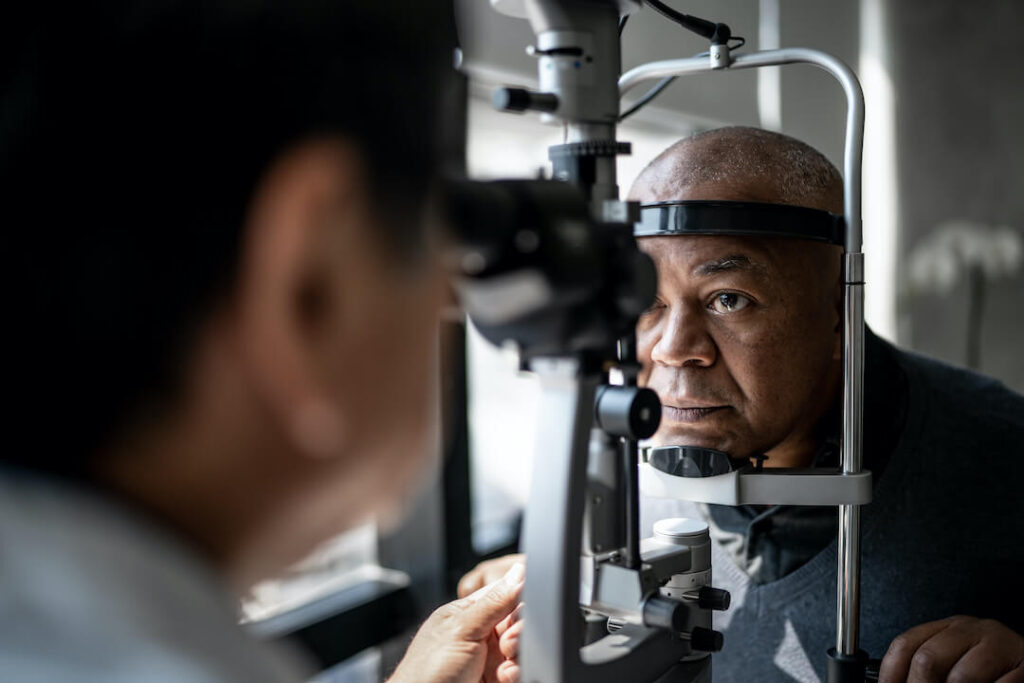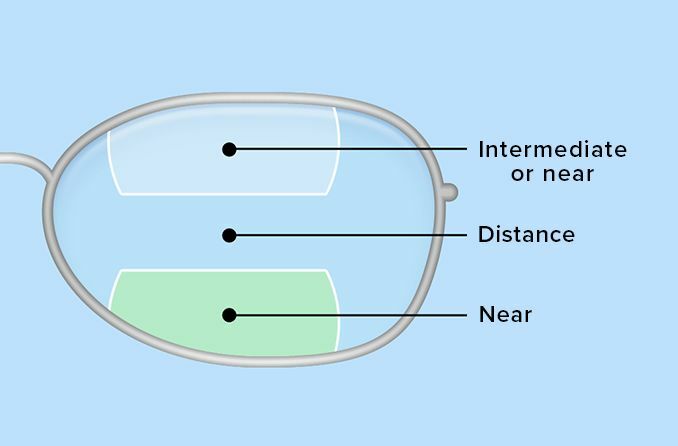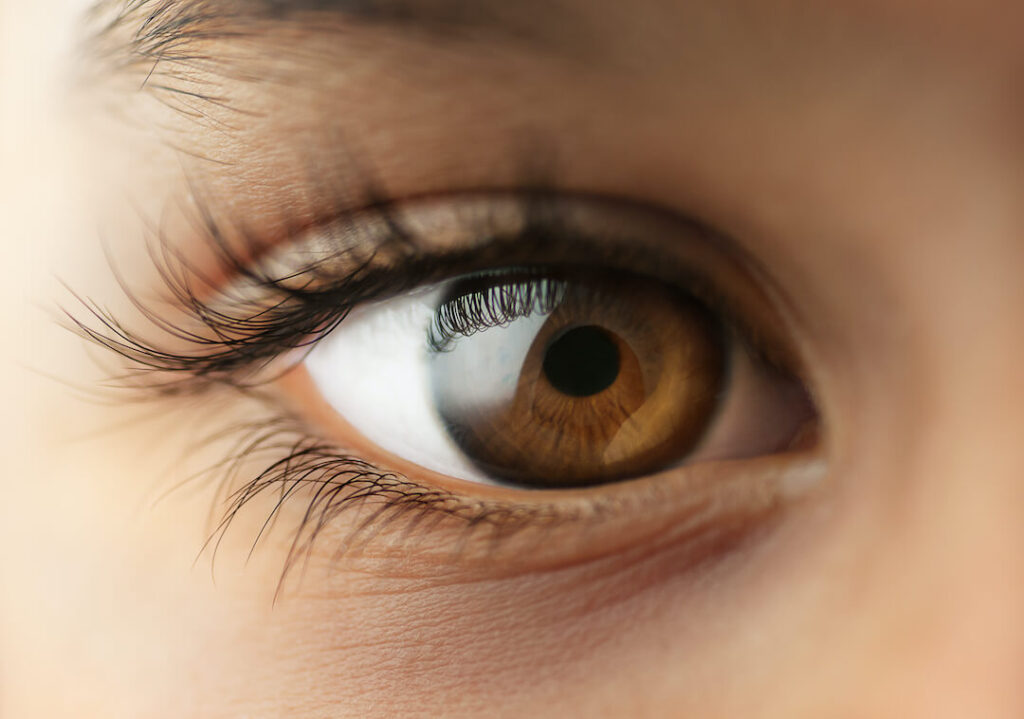Get all of the facts you need to know about contact lenses for presbyopia
If you’re having trouble seeing small text up close or find yourself needing to hold things far away in order to read them, you may need contact lenses for presbyopia. Millions of people suffer from presbyopia, this age-related eye condition that often requires corrective lenses. Thankfully, contact lenses specially designed for correcting vision caused by presbyopia can offer a much clearer view of life!
In this article, we’ll explore multifocal and bifocal contacts as well as monovision ones tailored specifically towards easing your symptoms of presbyopia. But don’t worry if those aren’t an option—eyeglasses and surgical procedures also exist so everyone can find what works best for their unique needs when it comes to getting back perfect 20/20 vision. To save on contact lenses for presbyopia, be sure to check out our enrollment options.
Table of Contents
Understanding Presbyopia
Before we can understand how to get contacts for presbyopia, we need to understand how it works

Typically, individuals who are in their 40s or 50s start to suffer from Presbyopia, a decrease in near vision due to the decreasing flexibility of our lenses as we age. People with certain medical conditions and those taking medications may also be more susceptible.
For presbyopia correction, there are several options available, such as spectacles, contact lenses, and surgical intervention. Each has its own set of benefits and drawbacks that should all be taken into account before making a decision. Contact lenses for this purpose help enhance visual clarity at close-up ranges along with intermediate or double vision at far distances by selecting the appropriate type/mode correction accordingly.
Causes of Presbyopia
As people age, the lens in their eyes becomes less flexible and rigid. This usually starts happening around one’s 40s or 50s and is known as an ‘age-related condition,’ which leads to presbyopia. Ultimately, presbyopia makes it harder for one lens in our eyes to focus on near objects. Other elements like hyperopia (farsightedness not related to aging) and diseases such as diabetes can accelerate this process, too.
Knowing what causes presbyopia assists in selecting a proper vision correction approach that fits your individual needs. Be it eyeglasses or contact lenses, you should consult with your optometrist before settling into any corrective measures.
Symptoms of Presbyopia
Presbyopia is often indicated by certain common symptoms like trouble seeing fine print, fatigue in the eyes, and having to move objects away for clarity. Signs of it typically start at around 40 years old with blurred vision from regular viewing distances as well as difficulty concentrating on near objects. Plus, you may exhibit a propensity to close up work or keep reading material farther away so that characters are more distinctive. Other potential warning signs include headaches and eyestrain.
The age range where presbyopia progressively intensifies starts when an individual reaches their mid-forties through until their sixties. Anyone observing these indications should seek advice from an eye care specialist immediately for verification purposes as well, and proper treatment measures can be put into place promptly.
Multifocal Contact Lenses: A Clear Vision Solution
For a lot of people, multifocal lenses are effective contact lenses for presbyopia

Multifocal contact lenses, also called multifocal contacts, are a great way to correct presbyopia without needing eyeglasses. These special lenses focus on different points in the visual field for more comfortable and natural vision at any distance. You can easily view near and far objects, all with one pair of lenses! There is an array of options available when it comes to multifocal contacts, like soft disposable or rigid gas-permeable varieties that cater perfectly to individual needs. Below, we will discuss the advantages and types these specialist prescription lenses offer so as better to guide your decision regarding their use for presbyopic correction.
Benefits of Multifocal Contact Lenses
Multifocal contact lenses provide numerous benefits compared to eyeglasses. With these special lenses, wearers can experience clarity of sight at all distances with no need for switching glasses and have a clear peripheral vision that progressive glasses often don’t offer. The adjustment period is easier than expected due to having no visible lines, which leads to a seamless transition of eye focus between different focal points while eliminating halos or glare from view.
All in all, this type of contact offers an improved visual experience through corrective functions as well as clearer and more natural eyesight.
Types of Multifocal Contact Lenses
When considering contact lenses to suit different vision requirements, multifocal soft contact lenses offer a range of design options. Bifocals can be segmented into an upper part providing distance vision and a lower section used for near-sightedness. Divided by a visible line between them. For simultaneous viewing at both distances, soft multifocal combines two sections, which are meant to work together without needing movement from within the lens itself, offering more natural use for wearers this way. Examining all types available is necessary so as to properly select one that will provide a smooth transition when switching between far and close sight ranges, with these specialized contacts fitting well on your eyesight needs overall.
Bifocal and Monovision Contact Lenses
Consult your optometrist to decide which type of contact lens for presbyopia
For presbyopia correction, contact lenses are available in two varieties, namely bifocal lenses and monovision. Bifocal lenses feature a visible line that divides the distant vision zone from the near vision zone. This allows for crystal-clear visual acuity at both levels of distance and nearness. Monovision lens contacts involve wearing separate pieces for each eye – with an individualized shape to guarantee optimal clarity no matter if it is far or close: that way, your brain will merge these images into one clear picture of the world around you.
When considering which type might be better suited for your lifestyle and eyesight needs, think about the advantages as well as disadvantages associated with either choice, such as wearability, comfort level, etc. Since every person’s conditions can differ immensely, only a thorough examination by an optometrist could provide you with a personalized answer to fully address any optical issues related to presbyopia treatment!
Bifocal Contact Lenses
Bifocal contact lenses are designed to give clear vision at both near and far distances. There are two distinct sections in these contacts with varying power, enabling them to be worn comfortably for long durations without any impairment of your vision. These types of bifocal lenses come manufactured by renowned brands such as Bausch + Lomb, Acuvue, CooperVision, or Biofinity and range from $30 – $120 a month (up to around 800 per year).
They also have segmented designs, which gives users greater choice when choosing the right one for their visual needs. All in all, it’s an excellent way to keep good eyesight while enjoying activities that involve different levels/distances away from you!
Monovision Contact Lenses
Monovision contact lenses offer a different kind of vision correction, providing clarity and quality at specific distances that are superior to what multifocal lenses can achieve. In this process, one eye is corrected for distant viewing while the other concentrates on close-up objects. When compared with multifocal contacts, monovision ones are usually more budget-friendly and easy to get your hands on.
Keep in mind, though, that these may not be suitable for everyone since it might require some time to get used to them. So, talk things out carefully with an ophthalmologist first before deciding if they’re right for you or not!
Fitting Process for Presbyopia Contact Lenses
Know what to expect when you visit your eye care provider for presbyopia contact lenses

When aiming to acquire the right contact lens for presbyopia correction, understanding the fitting stages like evaluation, prescription process, trial period, and adaptation is essential. A competent eye care professional will evaluate your vision clarity in the anterior eye, contrast sensitivity, and binocular single sight in order to determine which type of lenses would best suit you.
The following paragraphs cover assessment procedures, including prescriptions. Details on trial periods as well as suggestions when adapting with presbyopic lenses so that you can see clearly again soon!
Evaluation and Prescription
When deciding on a contact lens prescription for presbyopia, your eye care practitioner will undertake examinations to check both distance- and near vision. Tests such as the Snellen chart measure visual acuity, and CSV-1000 tests determine contrast sensitivity in various lighting with or without glare.
Assessments include ultrasounds, biomicroscopy, pupillometry, retinoscopy, and dynamic assessment of amplitude accommodation alongside negative relative accommodations.
Then, based upon all this information, an accurate, tailored prescription is made best suited to each individual’s needs regarding lenses needed for correct, effective sight purposes in relation to their own personal case of presbyopia.
Trial Period and Adaptation
Once you’ve got your contact lenses for presbyopia, it’s important to go through a trial period so that the best fit and comfort can be achieved. Adapting to these vision aids may take multiple weeks or months, involving getting used to seeing from both near and far simultaneously with each lens separately. It is recommended that the process of wearing corrective contacts start as soon as possible in order to make adaptation easier.
During this evaluation stage, it’s essential to tell your eye doctor if there are any issues or worries about how your contacts feel. Regular appointments will allow them to assess the clarity of sight when using the lenses, plus your overall contentment with them. Open communication allows for necessary corrections in design/prescription being made, giving you perfect vision and optimal correction for viewing up close and afar.
Caring for Your Presbyopia Contact Lenses
Keep your eyes safe and healthy by properly caring for your contact lenses for presbyopia
To ensure good eye health and steer clear of infections or any other possible complications, proper care and maintenance are essential for your contact lenses when dealing with presbyopia. Allowing them to be adequately disinfected by a multipurpose cleaning solution can help maintain their cleanliness as well as make sure they remain comfortable during wear.
Cleaning and Storage
Adhering to the instructions of your eye care specialist, it is important to practice ‘rub and rinse’ with presbyopia contact lenses. This includes rubbing them in a cleaning solution provided before rinsing. It’s also essential that each night, you store these contacts in an unsoiled lens case containing fresh multipurpose fluid, which should be poured out upon placing them back into your eyes the next morning. It’s best for hygiene reasons for you to update the container every 3 months, too!
Regular Eye Exams and Follow-up
Eye care professionals advise that presbyopia sufferers have eye exams regularly, every 1 to 2 years, even without any symptoms. Follow-up visits are beneficial for identifying and rectifying potential issues with the lenses they wear or in terms of vision correction.
Alternatives to Contact Lenses for Presbyopia
If you are unable to wear contact lenses, there are still other options to help with presbyopia

Contact lenses are a favored way of correcting presbyopia, but there are also other approaches that can be taken. Eyeglasses and surgical procedures may help you improve your vision. It is important to consider all available options before choosing the right one for your individual visual needs and lifestyle in terms of advantages versus disadvantages.
The following paragraphs provide insight into eyewear glasses and surgery as potential alternatives with regard to treating and Correcting Presbyopia alongside contact lenses so that users can make an educated decision about their own vision care plan accordingly.
Eyeglasses for Presbyopia
For presbyopia correction, eyeglasses are a tried-and-true solution. Reading glasses and bifocal or progressive lenses that provide an effortless switch between distance vision and near sight can also be worn in lieu of contact lenses. Eyewear for this condition produces clear optics at all distances without having to opt for surgery or contacts, which often costs more than eyewear alone. It is vital when selecting the best choice of specs to take into account one’s lifestyle, preference, and particular visual requirements before deciding on which type will work most effectively.
Surgical Options for Presbyopia
For those seeking a permanent fix for presbyopia, glasses may not be the only option. LASIK and conductive keratoplasty are possible surgical procedures available to correct vision and reduce dependency on reading eyewear.
It is important that you consult an eye care specialist before making any decisions about which treatment plan works best, as these surgeries come with their own potential risks and complications. With LASIK, lasers assist in correcting presbyopic sight, whereas radiofrequency energy reshapes the cornea, allowing improved near vision when utilizing conductive keratoplasty. Correcting or improving how we see requires considering each individual’s situation thoroughly. Through this process, doctors can help ensure our eyesight remains at its best.
Frequently Asked Questions About Contact Lenses for Presbyopia
Can contact lenses help with presbyopia?
Contact lenses are a useful aid to correct presbyopia. Many lenses provide multifocal capabilities, such as ACUVUE’s range of contacts, which focus on correcting this condition and enable the wearer to focus more easily on nearby objects. These multifocal contact lens- types can also help with other areas where precision is necessary due to their ability to be tailored correctly according to your needs when it comes to sight correction. Presbyopia isn’t something you have no option but to accept—these specialized multi-focalized lenses offer solutions that allow for precise focusing in any situation!
Which lens is best for presbyopia?
For presbyopia, bifocal or progressive lens eyeglasses are the most common and easiest treatment option. However, both multifocal contact lenses and monovision (or blended) contact lenses are available in either soft disposable or rigid gas-permeable lenses. Your optometrist will advise which is best for you.
What is the difference between presbyopia and multifocal contacts?
As many as 111 million Americans experience presbyopia, making it difficult to focus on objects up close. Multifocal contact lenses are an effective solution for those in their mid-40s who struggle with the condition, providing an improved ability to handle daily tasks without hassle or eye strain. These particular lenses contain multiple focuses, and a wide variety of different types makes them a versatile option when it comes to eyewear solutions.
Can I get contact lenses for reading only?
It is possible to acquire contact lenses specifically for reading, which offer the advantage of clear vision at any distance without having to use glasses. Some examples include Purevision Multifocal and Air Optix Multifocal. These particular varieties are created with a view toward a simultaneous vision design, eliminating the need for readers.
What is presbyopia?
Presbyopia is an age-related condition that occurs in millions of people worldwide, characterized by a gradual decrease in near vision as one age. It is accepted to be part and parcel of the advancing years.
When it comes to presbyopia correction, there are various types of contact lenses available for consideration – including multifocal lens, bifocal, and monovision lenses. It is important that the wearer not only takes good care of them but also gets regular eye exams and follow-up appointments in order to maintain optimal vision. Eyeglasses or even surgical options may be alternative solutions one might consider when dealing with this condition.
If you are struggling with blurred vision due to presbyopia, Linneo can help. With the help of individual vision insurance or an eyewear savings plan, you can save on corrective contact lenses. Explore our coverage options so you can get back to seeing clearly as soon as possible.

